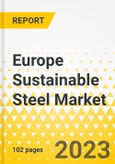10% Free customization
The Europe sustainable steel market (excluding U.K.) is projected to reach $165.9 billion by 2031 from $86.0 billion in 2022, growing at a CAGR of 7.57% during the forecast period 2022-2031. The growth of the sustainable steel industry in the European market is expected to be driven by strict government regulations, carbon neutrality goals, and the desire for energy and cost efficiency by using recycled steel. In addition, market expansion is anticipated due to the increased demand for steel as well as the scarcity of energy and raw materials. But obstacles including incomplete separation and complex product design, which can lead to impurities in recycled steel, and high infrastructure and green hydrogen costs might make it expensive to produce green steel, which could impede the market's growth. This report comes with 10% free customization, enabling you to add data that meets your specific business needs.
Market Introduction
Carbon neutrality goals, strict government regulations, and the growing need for affordable and energy-efficient solutions are driving a substantial development in the European market for sustainable steel. The sector wants to overcome the lack of raw materials and energy resources, with a focus on employing recycled steel. Still, there are issues, such as contaminants in recycled steel and the high cost of producing green steel because of infrastructure costs and the high cost of green hydrogen. Despite these obstacles, the industry is expected to grow as the area embraces the advantages of recycled and green steel solutions and keeps up its commitment to sustainability.Market Segmentation:
Segmentation 1: by End-Use Application
- Transportation
- Building and Construction
- Furniture and Appliances
- Packaging
- Others
Segmentation 2: by Technology
- Electric Arc Furnace (EAF)
- Blast Furnace-Basic Oxygen Furnace (BF-BOF)
- Others
Segmentation 3: by Region
- Europe - Germany, France, Italy, Spain, and Rest-of-Europe
How can this report add value to an organization?
Product/Innovation Strategy: The product segment helps the reader understand the different types of sustainable steel available and their potential in Europe region. Moreover, the study provides the reader with a detailed understanding of the different sustainable steel end-use applications in industries such as transportation, building and construction, furniture and appliances, packaging, and others.Competitive Strategy: Key players in the Europe sustainable steel market analyzed and profiled in the study involve sustainable steel providers. Moreover, a detailed competitive benchmarking of the players operating in the sustainable steel market has been done to help the reader understand how players stack against each other, presenting a clear market landscape. Additionally, comprehensive competitive strategies such as partnerships, agreements, and collaborations will aid the reader in understanding the untapped revenue pockets in the market.
Key Market Players and Competition Synopsis
The companies that are profiled have been selected based on inputs gathered from primary experts and analysing company coverage, product portfolio, and market penetration.Some of the prominent names established in this market are:
- ArcelorMittal
- LIBERTY Steel Group
- Lech Stahlwerke GmbH
- Celsa Group
- H2 Green Steel
This product will be delivered within 3-5 business days.
Table of Contents
1 Markets
2 Region
3 Markets-- Competitive Benchmarking & Company Profiles
List of Figures
List of Tables
Executive Summary
The Europe sustainable steel market (excluding U.K.) is estimated to reach $165.9 billion by 2031, reveals the premium market intelligence study. The study also highlights that the market is set to witness a CAGR of 7.57% during the forecast period 2022-2031.The Europe Sustainable Steel Market: Drivers and Challenges
One of the major factors for the growth and establishment of the sustainable steel market in this region is the introduction of stringent regulations mandated by the government, with a major focus on enhancing the overall product quality with reduced carbon footprints.The disruption of the supply chain brought on by the COVID-19 outbreak poses difficulties for manufacturers and end users. Furthermore, the Russia-Ukraine war and global monetary tightening have also hampered the overall rate of economic growth in Europe.
USPs of report
- Analysis of business drivers and challenges of the Europe Sustainable Steel Market
- Detailed analysis of Sustainable Steel Market for Germany, France, Spain and Italy
Analyst’s Perspective on Sustainable Steel Market
The Principal Analyst states, 'Increasing focus on climate change is driving the transition of energy-intensive and carbon-intensive industries. Although recycled steel is a sustainable option and caters to various end-use applications, green steel is expected to be the best option for the decarbonization of the steel industry in the long term. Stringent regulations and ongoing technological advancements are expected to boost the adoption of sustainable steel in various end-use industries. The growth in the sustainable steel market is estimated to be robust during the forecast period.'Some of the prominent names established in this market are:
- ArcelorMittal
- LIBERTY Steel Group
- Lech Stahlwerke GmbH
- Celsa Group
- H2 Green Steel
Key Questions Answered in the Report
- What are the major market drivers, challenges, and opportunities in the Europe sustainable steel market?
- What are some of the key initiatives taken by the existing players to improve their market positioning and strategies adopted by new players entering the market space?
Companies Mentioned
- ArcelorMittal
- LIBERTY Steel Group
- Lech Stahlwerke GmbH
- Celsa Group
- H2 Green Steel
Table Information
| Report Attribute | Details |
|---|---|
| No. of Pages | 102 |
| Published | December 2023 |
| Forecast Period | 2022 - 2031 |
| Estimated Market Value ( USD | $ 86 Billion |
| Forecasted Market Value ( USD | $ 165.9 Billion |
| Compound Annual Growth Rate | 7.5% |
| Regions Covered | Europe |
| No. of Companies Mentioned | 5 |









